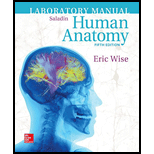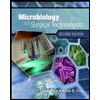
Laboratory Manual for Human Anatomy
5th Edition
ISBN: 9781259683831
Author: Eric Wise, Kenneth S. Saladin Dr.
Publisher: McGraw-Hill Education
expand_more
expand_more
format_list_bulleted
Concept explainers
Question
Chapter 2.1, Problem 3BYGO
Summary Introduction
To analyze:
The reason due to which cells cannot grow to unlimited size.
Introduction:
Several reactions are very crucial for the generation of energy to power up the cellular machinery and systems in the human body. Some examples of such reactions are glycolysis, tricarboxylic acid cycle, and electron transport chain. The main purpose of these reactions is to yield energy.
Expert Solution & Answer
Want to see the full answer?
Check out a sample textbook solution
Students have asked these similar questions
The Sentinel Cell: Nature’s Answer to Cancer?
Molecular Biology Question
You are working to characterize a novel protein in mice. Analysis shows that high levels of the primary transcript that codes for this protein are found in tissue from the brain, muscle, liver, and pancreas. However, an antibody that recognizes the C-terminal portion of the protein indicates that the protein is present in brain, muscle, and liver, but not in the pancreas. What is the most likely explanation for this result?
Molecular Biology
Explain/discuss how “slow stop” and “quick/fast stop” mutants wereused to identify different protein involved in DNA replication in E. coli.
Chapter 2 Solutions
Laboratory Manual for Human Anatomy
Ch. 2.1 - Prob. 1BYGOCh. 2.1 - Prob. 2BYGOCh. 2.1 - Prob. 3BYGOCh. 2.1 - Answer the following questions to test your...Ch. 2.2 - Prob. 1AWYKCh. 2.2 - Prob. 2AWYKCh. 2.2 - Prob. 5BYGOCh. 2.2 - Compare the structure and function of...Ch. 2.2 - What membrane transport processes get all the...Ch. 2.2 - Identify several reasons why the glycocalyx is...
Ch. 2.2 - Prob. 9BYGOCh. 2.2 - Prob. 10BYGOCh. 2.3 - Prob. 11BYGOCh. 2.3 - Prob. 12BYGOCh. 2.3 - Prob. 13BYGOCh. 2.3 - What three organelles are involved in protein...Ch. 2.3 - Prob. 15BYGOCh. 2.4 - State what occurs in each of the four phases of...Ch. 2.4 - Prob. 17BYGOCh. 2.4 - Prob. 18BYGOCh. 2.4 - Prob. 19BYGOCh. 2.4 - Discuss the advantages and disadvantages of adult...Ch. 2 - Prob. 2.1.1AYLOCh. 2 - How the light microscope transmission electron...Ch. 2 - Prob. 2.1.3AYLOCh. 2 - The distinction between the basal, apical, and...Ch. 2 - The size of a micrometer and some common and...Ch. 2 - Prob. 2.1.6AYLOCh. 2 - The meanings of plasma membrane, cytoplasm,...Ch. 2 - Prob. 2.1.8AYLOCh. 2 - Prob. 2.2.1AYLOCh. 2 - Prob. 2.2.2AYLOCh. 2 - Prob. 2.2.3AYLOCh. 2 - Prob. 2.2.4AYLOCh. 2 - The diverse physiological roles of membrane...Ch. 2 - Prob. 2.2.6AYLOCh. 2 - Prob. 2.2.7AYLOCh. 2 - Prob. 2.2.8AYLOCh. 2 - Prob. 2.2.9AYLOCh. 2 - Prob. 2.2.10AYLOCh. 2 - Prob. 2.2.11AYLOCh. 2 - The three components of the cytoskeleton, and how...Ch. 2 - Structure and function of a cell’s nucleus rough...Ch. 2 - Prob. 2.3.3AYLOCh. 2 - The four stages of the cell cycle and what events...Ch. 2 - The four stages of mitosis, what events occur in...Ch. 2 - Prob. 2.4.3AYLOCh. 2 - Prob. 2.4.4AYLOCh. 2 - The meaning of stem cells; their usefulness in...Ch. 2 - Prob. 1TYRCh. 2 - New nuclei form and a cell pinches in two during...Ch. 2 - Prob. 3TYRCh. 2 - Prob. 4TYRCh. 2 - Prob. 5TYRCh. 2 - Prob. 6TYRCh. 2 - Prob. 7TYRCh. 2 - Prob. 8TYRCh. 2 - Prob. 9TYRCh. 2 - Matter can leave a cell by any of the following...Ch. 2 - Prob. 11TYRCh. 2 - Prob. 12TYRCh. 2 - Prob. 13TYRCh. 2 - Prob. 14TYRCh. 2 - Prob. 15TYRCh. 2 - Prob. 16TYRCh. 2 - Prob. 17TYRCh. 2 - Prob. 18TYRCh. 2 - Prob. 19TYRCh. 2 - Prob. 20TYRCh. 2 - Prob. 1TOFCh. 2 - Prob. 2TOFCh. 2 - Prob. 3TOFCh. 2 - Prob. 4TOFCh. 2 - Prob. 5TOFCh. 2 - Prob. 6TOFCh. 2 - Prob. 7TOFCh. 2 - Prob. 8TOFCh. 2 - Prob. 9TOFCh. 2 - Briefly explain why each of the following...Ch. 2 - Prob. 1BYMVCh. 2 - Prob. 2BYMVCh. 2 - Prob. 3BYMVCh. 2 - Prob. 4BYMVCh. 2 - Prob. 5BYMVCh. 2 - Prob. 6BYMVCh. 2 - Prob. 7BYMVCh. 2 - Prob. 8BYMVCh. 2 - Prob. 9BYMVCh. 2 - State a meaning of each word element and give a...Ch. 2 - What would probably happen to the plasma membrane...Ch. 2 - Prob. 2TYCCh. 2 - Prob. 3TYCCh. 2 - Prob. 4TYCCh. 2 - Prob. 5TYC
Knowledge Booster
Learn more about
Need a deep-dive on the concept behind this application? Look no further. Learn more about this topic, biology and related others by exploring similar questions and additional content below.Similar questions
- Molecular Biology Question A gene that codes for a protein was removed from a eukaryotic cell and inserted into a prokaryotic cell. Although the gene was successfully transcribed and translated, it produced a different protein than it produced in the eukaryotic cell. What is the most likely explanation?arrow_forwardMolecular Biology LIST three characteristics of origins of replicationarrow_forwardMolecular Biology Question Please help. Thank you For E coli DNA polymerase III, give the structure and function of the b-clamp sub-complex. Describe how the structure of this sub-complex is important for it’s function.arrow_forward
- Molecular Biology LIST three characteristics of DNA Polymerasesarrow_forwardMolecular Biology RNA polymerase core enzyme structure contains what subunits? To form holo enzyme, sigma factor is added to core. What is the name of the structure formed? Give the detailed structure of sigma factor and the function of eachdomain. Please help. Thank youarrow_forwardMolecular Biology You have a single bacterial cell whose DNA is labelled with radioactiveC14. After 5 rounds of cell division, how may cells will contain radioactive DNA? Please help. Thank youarrow_forward
- 1. Explain the structure and properties of atoms and chemical bonds (especially how they relate to DNA and proteins). Also add some pictures.arrow_forward1. In the Sentinel Cell DNA integrity is preserved through nanoscopic helicase-coordinated repair, while lipids in the membrane are fortified to resist environmental mutagens. also provide pictures for this question.arrow_forwardExplain the structure and properties of atoms and chemical bonds (especially how they relate to DNA and proteins). Also add some pictures.arrow_forward
- In the Sentinel Cell DNA integrity is preserved through nanoscopic helicase-coordinated repair, while lipids in the membrane are fortified to resist environmental mutagens. also provide pictures for this question.arrow_forward1. Explain how genetic information is stored, copied, transferred, and expressed. Also add some pictures for this question.arrow_forward!. Describe biological macromolecules (DNA, RNA, proteins, lipids, etc.) and how they function in the cell. also provide some images for this question.arrow_forward
arrow_back_ios
SEE MORE QUESTIONS
arrow_forward_ios
Recommended textbooks for you
 Microbiology for Surgical Technologists (MindTap ...BiologyISBN:9781111306663Author:Margaret Rodriguez, Paul PricePublisher:Cengage Learning
Microbiology for Surgical Technologists (MindTap ...BiologyISBN:9781111306663Author:Margaret Rodriguez, Paul PricePublisher:Cengage Learning Human Physiology: From Cells to Systems (MindTap ...BiologyISBN:9781285866932Author:Lauralee SherwoodPublisher:Cengage Learning
Human Physiology: From Cells to Systems (MindTap ...BiologyISBN:9781285866932Author:Lauralee SherwoodPublisher:Cengage Learning





Microbiology for Surgical Technologists (MindTap ...
Biology
ISBN:9781111306663
Author:Margaret Rodriguez, Paul Price
Publisher:Cengage Learning

Human Physiology: From Cells to Systems (MindTap ...
Biology
ISBN:9781285866932
Author:Lauralee Sherwood
Publisher:Cengage Learning
Theory of Spontaneous generation | Abiogenesis and Biogenesis |; Author: subrata das;https://www.youtube.com/watch?v=tcyESFngVPk;License: Standard YouTube License, CC-BY